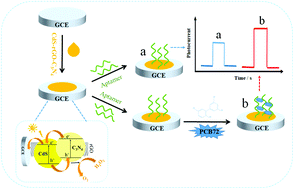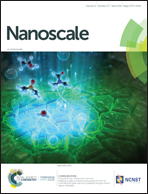One-pot synthesis of a CdS-reduced graphene oxide–carbon nitride composite for self-powered photoelectrochemical aptasensing of PCB72
Abstract
Graphitic carbon nitride (C3N4) is a carbon-based metal-free semiconductor, which has been widely explored as a photoactive material. In this work, the CdS, reduced graphene oxide (rGO) and C3N4 (CdS–rGO–C3N4) composite was synthesized by a simple one-pot hydrothermal method and utilized to construct a photoelectrochemical (PEC) sensor. Compared with CdS, C3N4 and CdS–C3N4, the CdS–rGO–C3N4 composite exhibited enhanced photoelectrochemical (PEC) performance, due to the expanded absorption of C3N4 in the visible region by CdS and promoted the charge carrier separation of a photoelectrode by rGO. Based on a glassy carbon electrode (GCE) modified with CdS–rGO–C3N4 and a PCB72-binding aptamer (ap/CdS–rGO–C3N4/GCE), a PEC aptasensor for the detection of 2,3′,5,5′-tetrachlorobiphenyl (PCB72) was developed. When H2O2 was added into the electrolyte, the PEC sensor exhibited an amplified response toward PCB72, and could be operated in a self-powered mode at a potential of 0 V. Under optimum conditions, the constructed PEC aptasensor exhibited a wide linear range of 10 to 1000 ng mL−1 for PCB72 detection, with a low detection limit (S/N = 3) of 1.0 ng mL−1. Moreover, this aptasensor exhibited high selectivity, good reproducibility and high stability. The applicability of the developed PEC strategy was demonstrated by determining PCB72 in environmental water.

- This article is part of the themed collection: Nanocarbons


 Please wait while we load your content...
Please wait while we load your content...